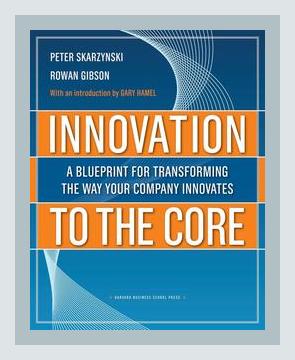Innovation and CreativityLeadership and ManagementInnovation ManagementInnovation Leadership
Innovation to the Core: A Summary
Overview
“Innovation to the Core” by Peter Skarzynski and Rowan Gibson, published in 2008, is a comprehensive guide on embedding innovation deeply within the fabric of an organization. The book fits into the categories of Innovation Leadership and Innovation Management, offering actionable insights and real-world examples. The authors argue that to sustain a competitive edge, companies must integrate innovation into their core processes and culture, rather than treating it as a peripheral activity.
Major Concepts and Actions
1. Establishing a Culture of Innovation
Concept: Cultivating an innovation-friendly environment is crucial. Organizations should foster a culture where creativity thrives and employees feel empowered to pursue new ideas without fear of failure.
Example: 3M’s “15-percent rule,” which allows employees to dedicate 15% of their working time to projects of personal interest, has led to significant innovations like the Post-it Note.
Action: Implement a flexible time policy that allows employees to explore their own innovative projects. Start with a pilot team and gradually scale it across the organization.
2. Strategic Alignment with Innovation
Concept: Aligning innovation efforts with the organization’s overall strategy ensures that new ideas contribute to long-term goals. This requires clear communication of strategic priorities so that innovation activities are relevant and impactful.
Example: IBM’s shift from hardware to a services-oriented business model involved aligning its innovation strategy with this new direction, focusing on service innovations and IT solutions.
Action: Conduct a strategic alignment workshop where leadership and key teams map out the company’s strategic goals and how innovation efforts can support them.
3. Leadership’s Role in Innovation
Concept: Leadership should not only support but actively contribute to innovation initiatives. Leaders set the tone by promoting an open environment and providing resources for innovation.
Example: Procter & Gamble’s leadership under A.G. Lafley focused on creating an open innovation model with their “Connect + Develop” strategy, which sought external ideas and collaborations.
Action: Leaders should take active roles in innovation steering committees to visibly endorse and support innovative projects. Regularly communicate the significance of innovation to all employees.
4. Building Innovation Capabilities
Concept: Developing an organization’s innovation capabilities involves investing in the skills, tools, and processes necessary for systematic innovation.
Example: Whirlpool established an innovation training program and set up innovation mentors to guide employees, leading to a variety of successful new products and improvements.
Action: Implement regular training sessions on innovation methodologies and tools like Design Thinking, Lean Startup, or TRIZ. Designate innovation mentors within the organization.
5. Creating a Robust Idea Pipeline
Concept: A robust idea pipeline ensures a continuous flow of innovative ideas. Organizations need mechanisms to capture, nurture, and develop these ideas into viable projects.
Example: Idea management platforms like Salesforce’s “IdeaExchange” allow employees and customers to submit and vote on ideas, ensuring a steady stream of innovations.
Action: Deploy an idea management system that encourages employees at all levels to submit ideas. Regularly review and reward the best contributions to maintain momentum.
6. Cross-Functional Collaboration
Concept: Innovation often occurs at the intersections of different disciplines and knowledge areas. Facilitating cross-functional collaboration brings diverse perspectives and sparks creative solutions.
Example: Google’s “20% time” policy has led to projects like Google News and Gmail, which emerged from employees collaborating across different teams and departments.
Action: Encourage cross-functional teams on innovation projects. Establish regular cross-departmental meetings to brainstorm and share insights.
7. Customer-Centric Innovation
Concept: Focusing on the customer’s needs and experiences can drive meaningful innovations. Understanding customer pain points and desires is essential for creating value.
Example: Starbucks’ engagement with its customers through the “My Starbucks Idea” platform has resulted in various changes and new offerings based on customer feedback.
Action: Set up channels for direct customer feedback and engage them in co-creation processes. Use surveys, social media, and customer panels to gather and act on insights.
8. Leveraging Technology
Concept: Current and emerging technologies can be significant enablers of innovation. Companies should stay abreast of technological trends and integrate relevant technologies into their innovation processes.
Example: GE’s adoption of Industrial Internet technologies to enhance the efficiency and capabilities of their machines, resulting in the creation of “Brilliant Machines.”
Action: Establish a technology scouting team to identify and evaluate new technologies. Invest in pilot projects to experiment with and understand potential applications.
9. Metrics and Rewards
Concept: Appropriate metrics and rewards encourage a sustained focus on innovation. Performance indicators should balance short-term achievements with long-term innovation goals.
Example: Microsoft uses a balanced scorecard approach to measure innovation performance, considering both financial and non-financial indicators.
Action: Develop a set of innovation metrics that cover input (number of ideas), process (speed to prototype), and output (revenue from new products). Create a reward system that recognizes innovative contributions.
10. Organizational Flexibility
Concept: Flexibility in organizational structure allows faster response to changes and opportunities. This can involve adopting a more modular and adaptable corporate structure.
Example: Apple’s success in consistently delivering innovative products is partly due to its flexible and flat organizational structure, which facilitates collaboration and swift decision-making.
Action: Consider restructuring teams into smaller, agile units that can pivot quickly when new opportunities arise. Promote a flat hierarchy to enable better communication and faster decision-making.
Conclusion
“Innovation to the Core” by Peter Skarzynski and Rowan Gibson presents a blueprint for embedding innovation deeply within an organization’s DNA. By fostering a culture of innovation, aligning it with strategic goals, and empowering leadership and teams, companies can create a sustainable competitive advantage. The book is enriched with real-world examples and offers specific actions to translate its concepts into practice, making it a valuable resource for anyone looking to lead and manage innovation effectively.
Innovation and CreativityLeadership and ManagementInnovation ManagementInnovation Leadership
